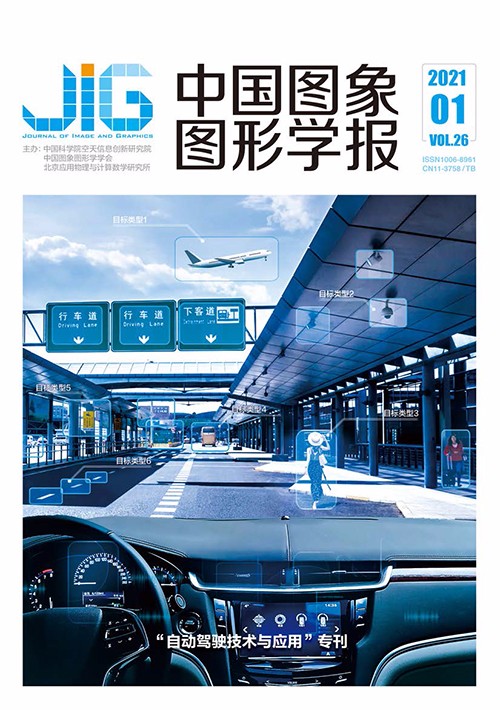
视觉感知的端到端自动驾驶运动规划综述
摘 要
视觉感知模块能够利用摄像机等视觉传感器获取丰富的图像和视频信息,进而检测自动驾驶汽车视野中的车辆、行人与交通标识等信息,是自动驾驶最有效、成本最低的感知方式之一。运动规划为自主车辆提供从车辆初始状态到目标状态的一系列运动参数和驾驶动作,而端到端的模型能够直接从感知的数据获取车辆的运动参数,因而受到广泛的关注。为了全面反映视觉感知的端到端自动驾驶运动规划方法的研究进展,本文对国内外公开发表的具有代表性和前沿的论文进行了概述。首先分析端到端方法的应用,以及视觉感知和运动规划在端到端自动驾驶中的作用,然后以自主车辆的学习方式作为分类依据,将视觉感知的端到端自动驾驶运动规划的实现方法分为模仿学习和强化学习两大类,并对各类方法的不同算法进行了归纳和分析;考虑到现阶段端到端模型的研究面临着虚拟到现实的任务,故对基于迁移学习的方法进行了梳理。最后列举与自动驾驶相关的数据集和仿真平台,总结存在的问题和挑战,对未来的发展趋势进行思考和展望。视觉感知的端到端自动驾驶运动规划模型的普适性强且结构简单,这类方法具有广阔的应用前景和研究价值,但是存在不可解释和难以保证绝对安全的问题,未来需要更多的研究改善端到端模型存在的局限性。
关键词
Review of end-to-end motion planning for autonomous driving with visual perception
Liu Yifei1, Hu Xuemin1, Chen Guowen1, Liu Shihao1, Chen Long2(1.School of Computer Science and Information Engineering, Hubei University, Wuhan 430062, China;2.School of Data and Computer Science, Sun Yat-sen University, Guangzhou 510006, China) Abstract
A visual perception module can use cameras to obtain various image features for detecting peripheral information, such as vehicles, pedestrians, and traffic signs in the visual field of self-driving vehicle. This module is an effective and low cost perception method for autonomous driving. Motion planning provides self-driving vehicles with a series of motion parameters and driving actions from the initial state to the target state of the vehicle. It makes the vehicle subject to collision avoidance and dynamic constraints from the external environment and spatial-temporal constraint from the internal system during the whole traveling process. Traditional autonomous driving approaches refer to constructing intermediate processes from the sensor inputs to the actuator outputs into a plurality of independent submodules, such as perception, planning, decision making, and control. However, traditional modular approaches require the design and selection of features, camera calibration, and manual adjustment of parameters. Therefore, autonomous driving systems based on traditional modular approaches do not have complete autonomy. With the rapid development of big data, computer performance, and deep learning algorithms, increasing researchers apply deep learning to autonomous driving. An end-to-end model based on deep learning obtains the vehicle motion parameters directly from the perceived data and can fully embody the autonomy of autonomous driving. Thus, this model has been widely investigated in recent years. The representative and cutting-edge papers published locally and overseas are summarized in this paper to fully review the research progress of end-to-end motion planning for autonomous driving with visual perception. Applications of the end-to-end model in computer vision tasks and games are introduced. The complexity of tasks solved by end-to-end approaches is higher than that of autonomous driving in some other fields. End-to-end approaches can be successfully applied in the commercial field of autonomous driving. The important roles of visual perception and motion planning in end-to-end autonomous driving are analyzed by comparing the advantages and disadvantages of different input and output modes. On the basis of the learning methods of autonomous vehicles, the implementation methods of end-to-end motion planning for autonomous driving with visual perception are divided into imitation learning and reinforcement learning. Imitation learning methods can be divided into two major mainstream algorithms, namely, behavior cloning and dataset aggregation. Two recently proposed imitation learning methods, including observation imitation and conditional imitation learning, are analyzed. In reinforcement learning, value-based and policy-based methods are mainly introduced. Advanced reinforcement learning methods, such as inverse reinforcement learning and hierarchical reinforcement learning, are presented. The research of the end-to-end model for autonomous driving faces transitions from virtual scenarios to real scenarios at this stage. Transfer learning methods are combined from three aspects, including image conversion, domain adaptation, and domain randomization. On this basis, the basic idea and network structure of each method are described. Autonomous driving models are usually evaluated in a simulation environment by means of public datasets and simulation platforms. The datasets and simulation platforms related to autonomous driving are listed and analyzed from the perspectives of publication time, configuration, and applicable condition. The existing problems, challenges, thinking, and outlook are summarized. End-to-end motion planning for autonomous driving with visual perception has strong universality and simple structure. However, explaining and ensuring absolute safety are difficult. The method of generating accountable intermediate representation is expected to solve the inexplicable problem. Therefore, end-to-end motion planning methods for autonomous driving with visual perception have a broad application prospect and research value. However, many studies are needed to improve the limitations of the proposed model in the future.
Keywords
visual perception motion planning end-to-end autonomous driving imitation learning reinforcement learning
|



 中国图象图形学报 │ 京ICP备05080539号-4 │ 本系统由
中国图象图形学报 │ 京ICP备05080539号-4 │ 本系统由